Digestive, Respiratory, and Urinary Systems Worksheet
Digestive System
1. Label the parts of the organ or structure, and describe the structure and its function.
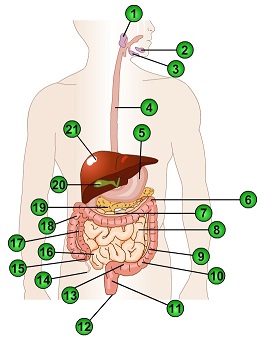
|
Number
|
Structure
|
Function
|
|
1
|
|
|
|
2
|
|
|
|
3
|
|
|
|
4
|
|
|
|
5
|
|
|
|
6
|
|
|
|
7
|
|
|
|
8
|
|
|
|
9
|
|
|
|
10
|
|
|
|
11
|
|
|
|
12
|
|
|
|
13
|
|
|
|
14
|
|
|
|
15
|
|
|
|
16
|
|
|
|
17
|
|
|
|
18
|
|
|
|
19
|
|
|
|
20
|
|
|
|
21
|
|
|
Digestive Enzymes: Pancreas
1. Label the parts of the organ or structure, and describe the structure and its function.
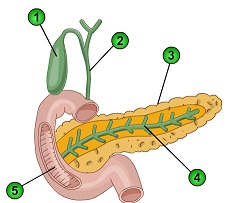
|
Number
|
Structure
|
|
1
|
|
|
2
|
|
|
3
|
|
|
4
|
|
|
5
|
|
2. Complete the following table:
|
Enzyme
|
What is the substance that the enzyme acts upon?
|
What are the products of the enzymatic action?
|
Where does the enzyme act in the digestive system?
|
|
Salivary amylase
|
|
|
|
|
Pepsin
|
|
|
|
|
Trypsin
|
|
|
|
|
Chymotrypsin
|
|
|
|
|
Carboxypepidase
|
|
|
|
|
Pancreatic lipase
|
|
|
|
|
Pancreatic amylase
|
|
|
|
Digestive Enzymes: Small Intestine
1. Label the parts of the organ or structure, and describe the structure and its function.
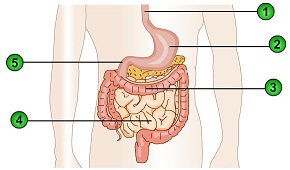
|
Number
|
Structure
|
Function
|
|
1
|
|
|
|
2
|
|
|
|
3
|
|
|
|
4
|
|
|
|
5
|
|
|
2. Describe how digestion is controlled by the nervous system and hormones.
3. Describe the processes of carbohydrate, lipid, and protein digestion and the absorption of the products of enzymatic action as they occur in the human mouth, stomach, and small intestine. Include a discussion of the enzymatic reactions involved in each organ.
4. What is the function of bile?
Respiratory System
1. Label the parts of the organ or structure, and describe the structure and its function.
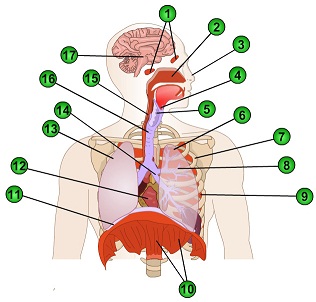
|
Number
|
Structure
|
Function
|
|
1
|
|
|
|
2
|
|
|
|
3
|
|
|
|
4
|
|
|
|
5
|
|
|
|
6
|
|
|
|
7
|
|
|
|
8
|
|
|
|
9
|
|
|
|
10
|
|
|
|
11
|
|
|
|
12
|
|
|
|
13
|
|
|
|
14
|
|
|
|
15
|
|
|
|
16
|
|
|
|
17
|
|
|
2. How does the brain control inspiration and expiration?
3. There are two sets of chemoreceptors in the body that control the respiration rate.
- Where are they located?
- How does each influence the rate of respiration?
4. Regarding the transport of carbon dioxide, answer the following:
- In which forms are carbon dioxide transported in the blood?
5. Regarding the transport of oxygen in human blood, answer the following:
- Which molecule is responsible for the transport of oxygen in human blood?
- Where is this molecule located in human blood?
6. Regarding the flow of air into and out of the lungs, answer the following:
- What drives the air flow into the lungs during inspiration?
- What drives the air flow out of the lungs during expiration?
Urinary System
1. Label the parts of the organ or structure, and describe the structure and its function.
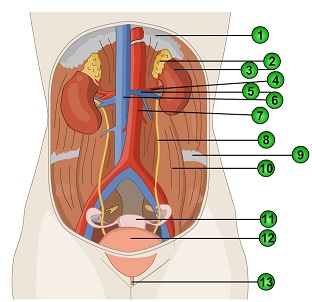
|
Number
|
Structure
|
Function
|
|
1
|
|
|
|
2
|
|
|
|
3
|
|
|
|
4
|
|
|
|
5
|
|
|
|
6
|
|
|
|
7
|
|
|
|
8
|
|
|
|
9
|
|
|
|
10
|
|
|
|
11
|
|
|
|
12
|
|
|
|
13
|
|
|
2. Describe how hormones and the kidney control blood pressure.
Internal Kidney Structure
1. Label the parts of the organ or structure, and describe the structure and its function.
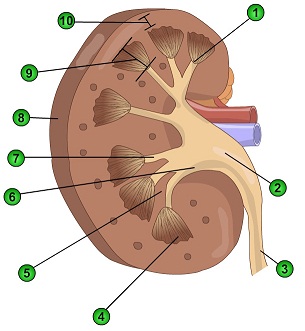
|
Number
|
Structure
|
Characteristics
|
Function
|
|
1
|
|
|
|
|
2
|
|
|
|
|
3
|
|
|
|
|
4
|
|
|
|
|
5
|
|
|
|
|
6
|
|
|
|
|
7
|
|
|
|
|
8
|
|
|
|
|
9
|
|
|
|
|
10
|
|
|
|
1. Concerning nitrogenous wastes in the human body, what are the different forms, and what are their sources?
2. What are the effects of the following hormones on the function of the distal convoluted tubule?
- ADH:
- Aldosterone:
3. Regarding the Bowman's capsule, answer the following:
- What drives the fluid from the glomerulus into the Bowman's capsule?
- What substances are moved from the glomerulus into the Bowman's capsule?
- What substances remain in the blood?
- In which portion of the nephron tubule is most of the salt (NaCl) and water reabsorbed from the filtrate?
- Which portion of the loop of Henle is highly permeable to water?
- Which portion of the loop of Henle is highly permeable to salt (NaCl)?
4. Hypertension, or high blood pressure, is known as the silent killer. Those who suffer from hypertension are often on a salt-reduced diet. What is the relationship between the amount of sodium ions in the blood and nephron function, urine volume, and blood pressure?
APA reference